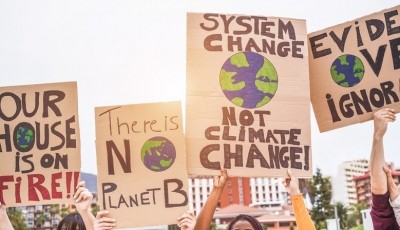Plant-forward diets may reduce greenhouse gases, but to meet nutritional needs, emissions would increase

“It would be satisfying to have a silver bullet to address carbon footprints and the impact of food production,” which plays a significant role in climate change, but “with problems as complex and global as nutrition, climate change, freshwater depletion and economic development, that’s not possible,” according to Martin Bloem, director for the center and the Robert Lawrence professor of environmental health at the Bloomberg School.
“There will always be tradeoffs,” he added in a statement accompanying the study he co-authored that was published Sept. 16 in the journal Global Environmental Change.
The study examined how nine different plant-forward dietary patterns across 140 countries would impact individual- and country-level greenhouse gas emissions and freshwater use and found there was no one-size-fits all diet that could simultaneously address climate change, obesity and undernutrition – all of which share food production and consumption as key underlying drivers.
Plant foods were generally the least GHG-intensive overall
To assess the impact of each diet, the researchers not only considered which foods were consumed, but took into account their impact on greenhouse gas, blue and green water footprints, the health of the population, and import patterns and associated difference between the production of foods in different countries of origin.
Broadly speaking, the researchers found that the most greenhouse gas intensive food source “by far” was ruminant meats, including cows, sheep and goats. Cow meat weighed in on average at 6.54 kg C02e/serving. This was 316 times more intensive than pulses, 115 times more than nuts & seeds and 40 times more than soy.
“Plant foods were generally the least GHG-intensive overall, often by an order of magnitude, even after accounting for GHGs associated with deforestation for palm oils and soy,” the study notes.
Similarly, the impact on blue water was most harmful for pond-raised fish and farmed crustaceans, it added.
Going beyond individual foods, the researchers found that while a vegan diet had the lowest environmental impact, not everyone needs to give up all meat to have a positive impact. Rather, it found that diets with protein predominantly from low food chain animals, such as small fish, were nearly as low as a vegan diet in terms of environmental impact. Similarly, adopting a ‘two-thirds vegan diet’ generally had a lower impact than a traditional vegetarian diet that includes eggs and cheese.
Impact of whole diets
The impact of whole diets on nutrition and the environment, however, is not as cut and dry as it is with individual food groups in part because of the impact posed by importing foods that on their own may have a lower environmental impact to replace locally grown foods.
For example, “a country-specific analysis reveals, for example, that shifting to the meatless day diet reduced GHG and water footprints in 47% and 57% of study countries, respectively – with some of the greatest per capita reductions in Paraguay, Israel and Brazil – even though the average net effect was an increase in footprints,” the study notes.
In another example, the authors note that one pound of beef from Paraguay creates 17 times more greenhouse gases than one pound of beef from Denmark.
Another wrinkle in the findings comes when the researchers considered nutrition guidelines for countries. This variable showed that even when a low red meat or meatless day diet was adopted by all countries alongside nutrition goals to account for under and over consumption, there was still an average net increase in diet-related greenhouse gas and water footprints. Most of this impact came from populous countries where under consumption is a significant problem.
In response, the authors stressed, “interventions that aim to address both sustainability and health goals must ensure plant-forward shifts are ambitious enough to offset the potential ecological burdens associated with providing adequate nutrition.”
Reflecting on these results, Bloem noted that “environmental impact alone cannot be a guide for what people eat; countries need to consider the totality of the nutritional needs, access and cultural preference of their residence.”
He added: “The good news is this research can be a part of the solution, as it now gives policymakers a tool to develop nationally appropriate strategies, including dietary guidelines that help meet multiple goals.”

















